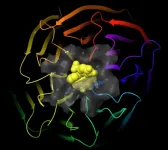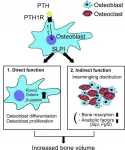The researchers will present their results today at the spring meeting of the American Chemical Society (ACS). ACS Spring 2021 is being held online April 5-30. Live sessions will be hosted April 5-16, and on-demand and networking content will continue through April 30. The meeting features nearly 9,000 presentations on a wide range of science topics.
"Using our proprietary small molecule probe and CRISPR guide RNA libraries, we screened a disease-relevant cell model that allowed us to pinpoint a treatment target," says Ivan V. Efremov, Ph.D., senior director, head of medicinal chemistry of Fulcrum Therapeutics, who is presenting the work.
Sickle cell disease occurs when the gene responsible for instructing cells to produce two of hemoglobin's four proteins contains an error. The mutation causes hemoglobin to adopt a rigid, sickle-like shape, which results in reduced oxygen transport throughout the body. The irregularly shaped cells get stuck in the blood vessels, causing painful episodes known as vaso-occlusive crises. The cells also die much sooner than normal red blood cells, leading to anemia. In addition to these symptoms, patients are at high risk of developing stroke, heart disease, kidney failure and other life-threatening conditions.
Interestingly, sickle cell patients don't begin life with malfunctioning hemoglobin. While in the womb, humans make "fetal" hemoglobin that carries oxygen normally. Three or four months after birth, however, cells stop expressing fetal hemoglobin and switch to an adult version. The adult hemoglobin expressed by sickle cell patients is defective, but they still carry stem cells in their bone marrow with the potential to produce fetal hemoglobin.
Patients that have what is called a hereditary persistence of fetal hemoglobin tap this resource automatically. "They have the sickle cell mutation, but additional mutations result in continued expression of fetal hemoglobin into adulthood," says Christopher Moxham, Ph.D., chief scientific officer of Fulcrum Therapeutics. With fetal hemoglobin levels around 25-30%, he says, enough red blood cell function is restored so that these patients may become asymptomatic.
The team developed a drug, called FTX-6058, that mimics the effect seen in patients with the hereditary persistence of fetal hemoglobin, as demonstrated in human-derived cell assay systems and mouse models. The drug attaches to a protein inside bone marrow stem cells destined to become mature red blood cells and reinstates their fetal hemoglobin expression. "What is really key is FTX-6058 upregulates fetal hemoglobin across all red blood cells, a pancellular distribution," Efremov says. "If some red blood cells did not express this, they could still sickle and cause disease symptoms." Fulcrum began a phase 1 safety trial in healthy adult volunteers last year after preclinical experiments showed an increase in fetal hemoglobin levels to around 25-30%.
"What distinguishes FTX-6058 is that we are targeting the root cause of sickle cell disease," Moxham says. "Other drugs approved in this space, particularly since 2019, are treating the disease's symptoms, either the anemia or the vaso-occlusive crises." Preclinical experiments comparing FTX-6058 with another fetal hemoglobin booster, hydroxyurea, approved in the 1990s, showed the new drug candidate outperforms the current treatment and, according to Moxham, offers the potential for a transformative therapy.
The team is currently designing a phase 2 clinical trial for people living with sickle cell disease that they plan to initiate by the end of 2021. They are also in the process of characterizing the therapeutic molecule further, using genomic technologies and additional cell assay systems to fill in the details of exactly how it works. Beyond sickle cell disease, Fulcrum is also considering a clinical strategy to explore the use of FTX-6058 in people living with β-thalassemia, a blood disorder in which hemoglobin production is reduced.
INFORMATION:
A press conference on this topic will be held Friday, April 9, at 10 a.m. Eastern time online at http://www.acs.org/acsspring2021conferences.
The researchers acknowledge internal funding from Fulcrum Therapeutics.
The American Chemical Society (ACS) is a nonprofit organization chartered by the U.S. Congress. ACS' mission is to advance the broader chemistry enterprise and its practitioners for the benefit of Earth and all its people. The Society is a global leader in promoting excellence in science education and providing access to chemistry-related information and research through its multiple research solutions, peer-reviewed journals, scientific conferences, eBooks and weekly news periodical Chemical & Engineering News. ACS journals are among the most cited, most trusted and most read within the scientific literature; however, ACS itself does not conduct chemical research. As a specialist in scientific information solutions (including SciFinder® and STN®), its CAS division powers global research, discovery and innovation. ACS' main offices are in Washington, D.C., and Columbus, Ohio.
To automatically receive news releases from the American Chemical Society, contact newsroom@acs.org.
Note to journalists: Please report that this research was presented at a meeting of the American Chemical Society.
Follow us: Twitter | Facebook
Title
Discovery of clinical candidate FTX-6058: a potent, orally bioavailable upregulator of fetal hemoglobin for treatment of sickle cell disease
Abstract
Sickle cell disease (SCD) is a genetic disorder of the red blood cells caused by a mutation in the HBB gene. This gene encodes a protein that is a key component of hemoglobin, a protein complex whose function is to transport oxygen in the body. The result of the mutation is less efficient oxygen transport and the formation of red blood cells that have a sickle shape. These sickle shaped cells are much less flexible than healthy cells and can block blood vessels or rupture, leading to anemia. SCD patients typically suffer from serious clinical consequences, which may include anemia, pain, infections, stroke, heart disease, pulmonary hypertension, kidney failure, liver disease and reduced life expectancy. Upregulation of fetal hemoglobin is a promising approach to treat sickle cell disease. This presentation will describe the medicinal chemistry strategy that resulted in clinical candidate FTX-6058, a ligand for the EED (Embryonic Ectoderm Development) subunit of the PRC2 complex. The validation of EED as a target for sickle cell disease was conducted using Fulcrum's proprietary Product Engine, which identified that blockade of PRC2 activity by ligands of EED or genetic knockdown of EED elicits robust upregulation of fetal hemoglobin (HbF) in primary human CD34+ hematopoietic stem cells carrying the SCD mutation. Oral administration of EED ligands also elevates HbF in murine models of sickle cell disease. The discovery of FTX-6058 leveraged structure-based drug design with multiparameter optimization of physico-chemical properties. De novo design of a macrocyclic scaffold afforded a chemical series with the desired overlap of pharmacology and DMPK parameters. Preclinical data with FTX-6058 showed an increase in HbF levels up to approximately 30% of total hemoglobin. We will also include insights from our Phase 1 clinical study.





